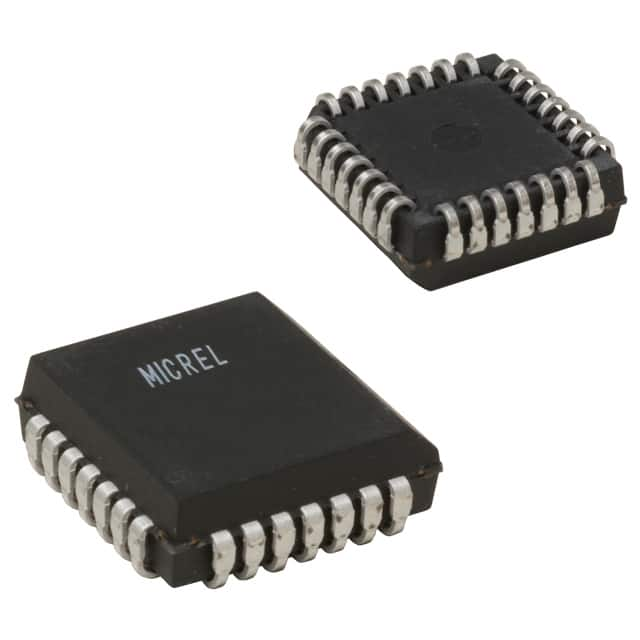Vedi le specifiche per i dettagli del prodotto.

SY100E143JC
Overview
Category: Integrated Circuit (IC)
Use: Digital Logic Gate
Characteristics: - High-speed operation - Low power consumption - Wide operating voltage range - Compatible with other ECL logic families
Package: 20-pin PLCC (Plastic Leaded Chip Carrier)
Essence: The SY100E143JC is a digital logic gate IC that operates at high speeds while consuming low power. It belongs to the ECL (Emitter-Coupled Logic) logic family and is widely used in various electronic applications.
Packaging/Quantity: The SY100E143JC is typically packaged in reels or tubes, containing a specific quantity of ICs per package. The exact packaging and quantity may vary depending on the manufacturer.
Specifications
- Supply Voltage Range: -4.2V to -5.7V
- Operating Temperature Range: -40°C to +85°C
- Input Voltage High (VIH): -1.3V (min), -1.0V (max)
- Input Voltage Low (VIL): -2.0V (min), -1.6V (max)
- Output Voltage High (VOH): -1.3V (min), -1.0V (max)
- Output Voltage Low (VOL): -2.0V (min), -1.6V (max)
- Propagation Delay Time (tpd): 0.9ns (typical), 1.8ns (max)
Pin Configuration
The SY100E143JC has a 20-pin PLCC package with the following pin configuration:
__ __
|01| |20|
|02| |19|
|03| |18|
|04| |17|
|05| |16|
|06| |15|
|07| |14|
|08| |13|
|09| |12|
|10| |11|
‾‾ ‾‾
Functional Features
- High-speed operation: The SY100E143JC is designed to operate at high speeds, making it suitable for applications that require fast data processing.
- Low power consumption: This IC consumes low power, contributing to energy-efficient electronic systems.
- Wide operating voltage range: It can operate within a wide voltage range, providing flexibility in various power supply configurations.
- Compatibility with other ECL logic families: The SY100E143JC is compatible with other ECL logic families, allowing seamless integration into existing systems.
Advantages and Disadvantages
Advantages: - High-speed operation enables efficient data processing. - Low power consumption contributes to energy efficiency. - Wide operating voltage range provides flexibility in power supply configurations. - Compatibility with other ECL logic families allows easy integration.
Disadvantages: - Limited availability of alternative models may restrict design options. - Higher cost compared to some other logic families.
Working Principles
The SY100E143JC operates based on the principles of Emitter-Coupled Logic (ECL). ECL is a type of digital logic circuit that uses differential amplifiers to achieve high-speed operation. The IC utilizes this principle to process digital signals accurately and quickly.
Detailed Application Field Plans
The SY100E143JC finds applications in various fields, including: 1. Telecommunications: Used in high-speed data transmission systems, such as optical networks and wireless communication. 2. Computer Systems: Employed in high-performance computing applications, such as servers and supercomputers. 3. Industrial Automation: Utilized in control systems requiring fast and reliable signal processing. 4. Test and Measurement: Integrated into equipment for precise measurement and analysis of digital signals.
Detailed and Complete Alternative Models
- SY100E143JCTR: 20-pin PLCC package, tape and reel packaging.
- MC10E143FN: 20-pin PLCC package, tube packaging.
- SN74F04N: 14-pin DIP (Dual Inline Package) package, tube packaging.
These alternative models offer similar functionality to the SY100E143JC and can be considered as replacements depending on specific requirements.
Note: The above list is not exhaustive, and there may be other alternative models available in the market.
In conclusion, the SY100E143JC is a high-speed digital logic gate IC belonging to the ECL logic family. It offers advantages such as high-speed operation, low power consumption, and compatibility with other ECL logic families. Its applications span across telecommunications, computer systems, industrial automation, and test and measurement fields. Alternative models like SY100E143JCTR, MC10E143FN, and SN74F04N provide options for different packaging and quantity preferences.
10 domande e risposte comuni relative all'applicazione di SY100E143JC nelle soluzioni tecniche
Sure! Here are 10 common questions and answers related to the application of SY100E143JC in technical solutions:
Q: What is SY100E143JC? A: SY100E143JC is a high-speed, low-power ECL (Emitter-Coupled Logic) flip-flop IC (Integrated Circuit) commonly used in digital communication systems.
Q: What are the key features of SY100E143JC? A: The key features of SY100E143JC include high-speed operation, low power consumption, differential inputs, and differential outputs.
Q: What is the maximum operating frequency of SY100E143JC? A: SY100E143JC can operate at frequencies up to several gigahertz, making it suitable for high-speed applications.
Q: How does SY100E143JC handle input signals? A: SY100E143JC uses differential inputs, which means it compares the voltage levels between two input pins to determine the logic state.
Q: Can SY100E143JC be used in both synchronous and asynchronous applications? A: Yes, SY100E143JC can be used in both synchronous and asynchronous applications, depending on the system requirements.
Q: What is the power supply voltage range for SY100E143JC? A: The power supply voltage range for SY100E143JC typically ranges from -5.2V to -3.8V.
Q: Does SY100E143JC support multiple output modes? A: Yes, SY100E143JC supports multiple output modes, including single-ended and differential outputs.
Q: Can SY100E143JC be cascaded with other flip-flops or logic devices? A: Yes, SY100E143JC can be cascaded with other flip-flops or logic devices to build more complex digital circuits.
Q: What are some typical applications of SY100E143JC? A: SY100E143JC is commonly used in high-speed data communication systems, clock distribution networks, and digital signal processing applications.
Q: Are there any specific design considerations when using SY100E143JC? A: Yes, some design considerations include proper termination of input and output lines, careful power supply decoupling, and attention to signal integrity at high frequencies.
Please note that the answers provided here are general and may vary depending on the specific application and requirements.

